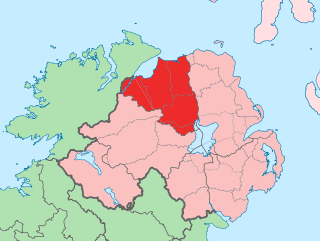
County Londonderry, also known as County Derry, is one of the six counties of Northern Ireland, one of the thirty-two counties of Ireland and one of the nine counties of Ulster. Before the partition of Ireland, it was one of the counties of the Kingdom of Ireland from 1613 onward and then of the United Kingdom after the Acts of Union 1800. Adjoining the north-west shore of Lough Neagh, the county covers an area of 2,118 km2 (818 sq mi) and today has a population of about 252,231.

Limavady is a market town in County Londonderry, Northern Ireland, with Binevenagh as a backdrop. Lying 17 miles (27 km) east of Derry and 14 miles (23 km) southwest of Coleraine, Limavady had a population of 11,279 people at the 2021 Census. In the 40 years between 1971 and 2011, Limavady's population nearly doubled. Limavady is within Causeway Coast and Glens Borough.

NI Railways, also known as Northern Ireland Railways, is the railway operator in Northern Ireland. NIR is a subsidiary of Translink, whose parent company is the Northern Ireland Transport Holding Company (NITHCo), and is one of nine publicly owned train operators in the United Kingdom, the others being Direct Rail Services, Caledonian Sleeper, Northern Trains, Transport for Wales Rail, Southeastern, LNER, ScotRail, and TransPennine Express. It has a common Board of Management with the other two companies in the group, Ulsterbus and Metro.

Coleraine is a town and civil parish near the mouth of the River Bann in County Londonderry, Northern Ireland. It is 55 miles (89 km) north-west of Belfast and 30 miles (48 km) east of Derry, both of which are linked by major roads and railway connections. It is part of Causeway Coast and Glens district. Coleraine had a population of 24,483 people in the 2021 census.

Lough Foyle, sometimes Loch Foyle, is the estuary of the River Foyle, on the north coast of Ireland. It lies between County Londonderry in Northern Ireland and County Donegal in the Republic of Ireland. Sovereignty over the waters has been in dispute since the Partition of Ireland.

Binevenagh is a large, steep-sided hill in County Londonderry, Northern Ireland. It is part of the Keenaght Hills, which mark the western edge of the Antrim Plateau, formed around 60 million years ago by molten lava. Binevenagh and its cliffs overlook the Magilligan peninsula and dominate the skyline over the villages of Bellarena, Downhill, Castlerock and Benone beach. The area has been classified as both an Area of Special Scientific Interest and as an Area of Outstanding Natural Beauty (AONB). The total area of the AONB is 138 km2.

Castlerock is a seaside village in County Londonderry, Northern Ireland. It is five miles west of Coleraine, and part of Causeway Coast and Glens district. It is very popular with summer tourists, with numerous apartment blocks and two caravan sites. Castlerock Golf Club has both 9-hole and 18-hole links courses bounded by the beach, the River Bann and the Belfast to Derry railway line. The village had a population of 1,155 people at the 2021 census, and is where near by village Articlave F.C play their home games.

The Belfast–Derry line is an intercity railway line, running from Belfast to Derry in Northern Ireland.

The Coleraine–Portrush line is a short railway branch line in Northern Ireland between the town of Coleraine in County Londonderry and the seaside resort of Portrush in County Antrim. The line, which is operated by NI Railways and referred to as the Portrush Line, has two intermediate halts and connects to the main Belfast–Derry line at Coleraine.

Castlerock railway station serves the villages of Castlerock, Articlave and their surrounding hamlets in County Londonderry, Northern Ireland. Walkers use the station to reach Mussenden Temple, Downhill Strand and Benone.

The Crumlin Road Courthouse is a former judicial facility on Crumlin Road in Belfast, Northern Ireland. It is a Grade B+ listed building.

Benone is a popular tourist destination in the Causeway Coast and Glens district, County Londonderry, Northern Ireland.

Causeway Coast and Glens is a local government district covering most of the northern part of Northern Ireland. It was created on 1 April 2015 by merging the Borough of Ballymoney, the Borough of Coleraine, the Borough of Limavady and the District of Moyle. The local authority is Causeway Coast and Glens Borough Council.
The High Sheriff of County Londonderry is King Charles III's judicial representative in County Londonderry. Initially an office for lifetime, assigned by the ruling monarch, the High Sheriff became annually appointed from the Provisions of Oxford in 1258. Besides his judicial importance, he has ceremonial and administrative functions and executes High Court Writs.
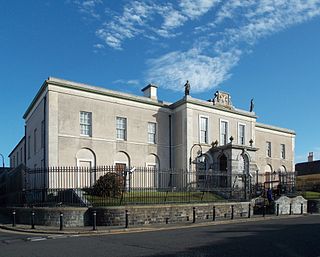
Downpatrick Courthouse is a judicial facility on English Street, Downpatrick, County Down, Northern Ireland. The courthouse, which served as the headquarters of Down County Council from 1878 to 1973, is a Grade B+ listed building.
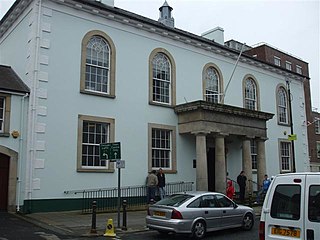
Enniskillen Courthouse is a judicial facility in East Bridge Street, Enniskillen, County Fermanagh, Northern Ireland. It is a Grade B listed building.

The Bishop Street Courthouse is a judicial facility in Bishop Street, Derry, County Londonderry, Northern Ireland. It is a Grade A listed building.

Omagh Courthouse is a judicial facility in High Street, Omagh, County Tyrone, Northern Ireland. It is a Grade B+ listed building.
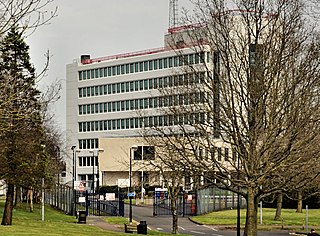
County Hall is a municipal facility in Coleraine, County Londonderry, Northern Ireland. It served as the headquarters of Londonderry County Council from 1960 to 1973.
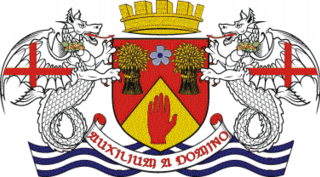
Londonderry County Council was the authority responsible for local government in County Londonderry, Northern Ireland.




















